字符串
C++ 提供了两种类型的字符串表示形式:
- C 风格字符串
- C++ 引入的 string 类类型
一、C风格字符串
字符串实际上是使用 null 字符 '�' 终止的一维字符数组。因此,一个以 null 结尾的字符串,包含了组成字符串的字符。
下面的声明和初始化创建了一个 "Hello" 字符串。由于在数组的末尾存储了空字符,所以字符数组的大小比单词 "Hello" 的字符数多一个。
char greeting[6] = {'H', 'e', 'l', 'l', 'o', '�'};
依据数组初始化规则,您可以把上面的语句写成以下语句:
char greeting[] = "Hello";
字符串的内存表示: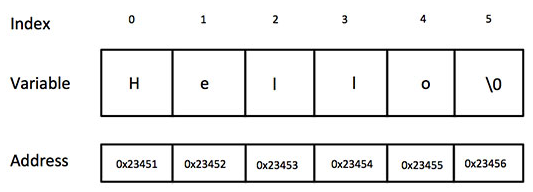
不需要把 null 字符放在字符串常量的末尾。C++ 编译器会在初始化数组时,自动把 '�' 放在字符串的末尾
#include <iostream> using namespace std; int main () { char greeting[6] = {'H', 'e', 'l', 'l', 'o', '�'}; cout << "Greeting message: "; cout << greeting << endl; return 0; }
Greeting message:Hello
二、字符串函数
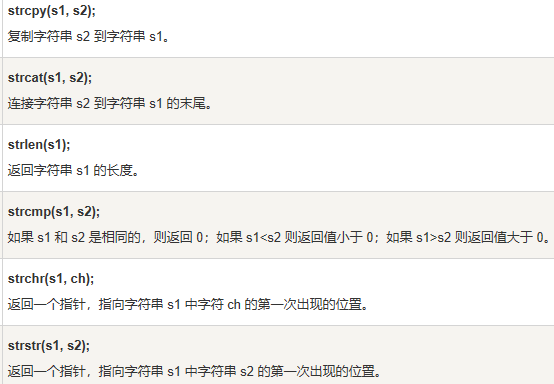
实例:
#include <iostream> #include <cstring> using namespace std; int main () { char str1[11] = "Hello"; char str2[11] = "World"; char str3[11]; int len ; // 复制 str1 到 str3 strcpy( str3, str1); cout << "strcpy( str3, str1) : " << str3 << endl; // 连接 str1 和 str2 strcat( str1, str2); cout << "strcat( str1, str2): " << str1 << endl; // 连接后,str1 的总长度 len = strlen(str1); cout << "strlen(str1) : " << len << endl; return 0; }
运行结果:
strcpy( str3, str1) : Hello
strcat( str1, str2): HelloWorld
strlen(str1) : 10
三、C++ 中的 String 类 ——— C++ 标准库提供string 类类型
实例:
#include <iostream> #include <string> using namespace std; int main () { string str1 = "Hello"; string str2 = "World"; string str3; int len ; // 复制 str1 到 str3 str3 = str1; cout << "str3 : " << str3 << endl; // 连接 str1 和 str2 str3 = str1 + str2; cout << "str1 + str2 : " << str3 << endl; // 连接后,str3 的总长度 len = str3.size(); cout << "str3.size() : " << len << endl; return 0; }
运行结果:
str3 : Hello str1 + str2 : HelloWorld str3.size() : 10
补充:
1. string类提供了一系列针对字符串的操作,比如:
- 1. append() -- 在字符串的末尾添加字符
- 2. find() -- 在字符串中查找字符串
- 4. insert() -- 插入字符
- 5. length() -- 返回字符串的长度
- 6. replace() -- 替换字符串
- 7. substr() -- 返回某个子字符串
#include <iostream> #include <string> using namespace std; int main() { //定义一个string类对象 string http = "www.runoob.com"; //打印字符串长度 cout<<http.length()<<endl; //拼接 http.append("/C++"); cout<<http<<endl; //打印结果为:www.runoob.com/C++ //删除 int pos = http.find("/C++"); //查找"C++"在字符串中的位置 cout<<pos<<endl; http.replace(pos, 4, ""); //从位置pos开始,之后的4个字符替换为空,即删除 cout<<http<<endl; //找子串runoob int first = http.find_first_of("."); //从头开始寻找字符'.'的位置 int last = http.find_last_of("."); //从尾开始寻找字符'.'的位置 cout<<http.substr(first+1, last-first-1)<<endl; //提取"runoob"子串并打印 return 0; }
2. cin.getline() 是在输入一段字符完成后开始读取数据(注意,是输入完成后,以Enter为结束标志)
实例:输入一串字符,编程统计其中的数字个数和英文字母个数。输入的字符以 # 为结束标志。
#include<iostream> using namespace std; #define N 100 int main() { char X[N]; cin.getline(X,N); //以cin.getline形式输入 int a=0,b=0; for(int i=0;i<N;i++) { if(X[i]=='#') //为#为结束标志 break; if(X[i]>='0'&&X[i]<='9') a++; //统计数字个数 if((X[i]>='a'&&X[i]<='z')||(X[i]>='A'&&X[i]<='Z')) b++; //统计英文字母个数 } cout<<a<<endl<<b<<endl; return 0; }
3.字符串与vector

4.sizeof 和 strlen
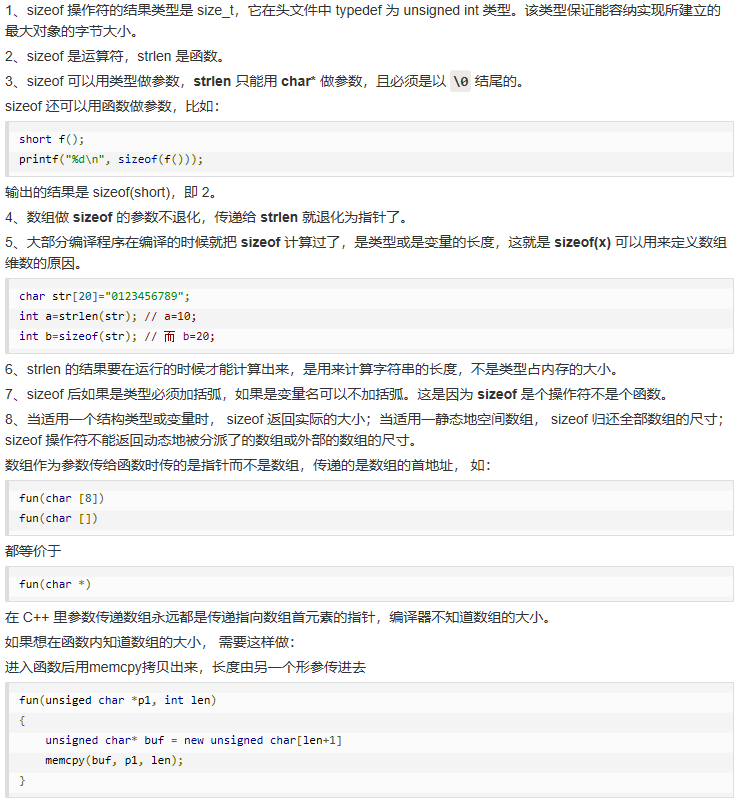
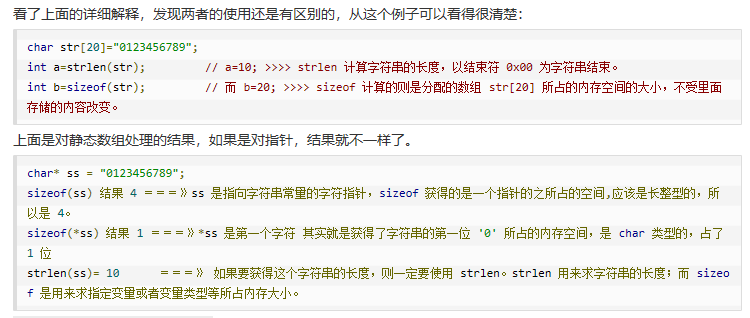
5.关于字符数组为什么可以以数组名来用cout输出数组内容,而普通数组不行
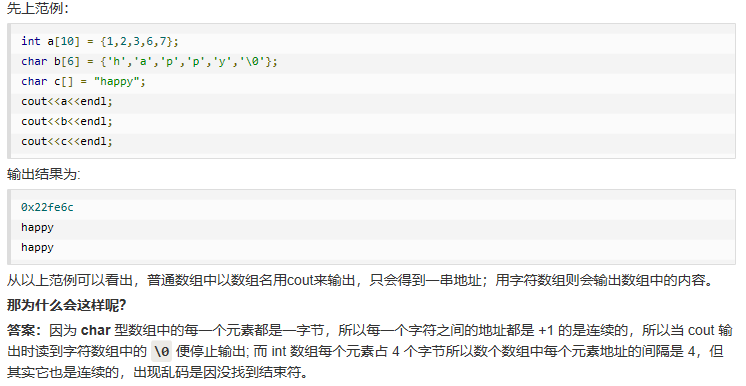
6.<cstring> 创建详解
#include<iostream> #include<algorithm> #include<cmath> #include<cstring> #include<cstdio> using namespace std; int main() { //1. 字符串的创建 cout<<"第一:字符串的创建! "; string a(4,'a'); cout<<"1.以 a 为原字符 4单位大小 "; cout<<"string a(4,'a'); cout<<a<<endl; "; cout<<a<<endl<<endl; cout<<"2.任意大小的字符串 "; cout<<"string b("bbbbbb"); cout<<b<<endl; "; string b("bbbbbb"); cout<<b<<endl<<endl; cout<<"3.把某一字符串的某一部分 (0位置开始4个长度)给c "; cout<<"string c(a,0,4) ; cout<<c<<endl; "; string c(a,0,4) ; cout<<c<<endl<<endl; cout<<"4. 10长度原长度不足补*; "; cout<<"c.resize(10,'*'); cout<<c<<endl; "; c.resize(10,'*'); cout<<c<<endl<<endl; system("pause"); system("cls"); return 0; }
7.<cstring> assign() 、 copy() 详解
#include<iostream> #include<algorithm> #include<cmath> #include<cstring> #include<cstdio> using namespace std; int main() { cout<<"第二: 字符串的赋值 assign();"<<endl; cout<<"1.感觉就像是append不过是抹除-覆盖 "; cout<<"string e; char f[10]="123456" e.assign(f); e+=' '; cout<<e<<endl<<endl; "; string e; char f[10]="123456"; e.assign(f); e+=' '; cout<<e<<endl<<endl; cout<<"2.string区间 赋值都类似吧 "; cout<<"e.assign(f,3,3); e+=' '; cout<<e<<endl<<endl; e.assign(f,3); cout<<e<<endl; "; e.assign(f,3,3); e+=' '; cout<<e<<endl; e.assign(f,3); cout<<e<<endl<<endl; cout<<"3.某字符串char型 全部 "; cout<<"char ssr[10]="asdqwezxc"; e.assign(ssr); cout<<ssr<<endl; "; char ssr[10]="asdqwezxc"; e.assign(ssr); cout<<ssr<<endl<<endl; cout<<"4.某字符串char型 前num个 "; cout<<"e.assign(ssr,4); cout<<e<<endl; "; e.assign(ssr,4); cout<<e<<endl<<endl; cout<<"5.某字符赋值 "; cout<<"赋值3个6 "; e.assign(3,'6'); cout<<e<<endl<<endl; cout<<"copy() 将d中的2位置开始的12个字符覆盖到char型数组ss上 必须为-> char型 <-否则报错"; cout<<" char ss[10]="123"; string dd; d.copy(ss,12,2); cout<<ss<<endl; "; char ss[15]="123"; string dd("abcdefghijklmn"); dd.copy(ss,12,2); cout<<ss<<endl<<endl; system("pause"); system("cls"); return 0; }
8.<cstring> append() 详解及其扩展(int, char):
#include<iostream> #include<algorithm> #include<cmath> #include<cstring> #include<cstdio> using namespace std; int main() { cout<<"第三: 字符串的添加与复制 append(); string d(a); cout<<d<<endl; //或者 d=d+a;/nd.append(b); "; cout<<"1.在d的末尾添加字符串a "; string d(a); d.append(b); cout<<d<<endl<<endl; cout<<"2.在d的末尾添加字符串/nb(0位置开始,2个长度)的数据 "; cout<<"d.append(b,0,2); cout<<d<<endl; "; d.append(b,0,2); cout<<d<<endl<<endl; cout<<"3.添加4个 ~ 字符 "; cout<<"d.append(4,'~'); "; cout<<"cout<<d<<endl<<endl; "; d.append(4,'~') ; cout<<d<<endl<<endl; system("pause"); system("cls"); cout<<"4. int 与 char 型添加 (好高兴自己想到的int ^_^ ) "; cout<<"char app[100]="aaabbb";"; cout<<" string charr("-_-"); "; cout<<"charr.append(app); cout<<charr<<endl "; char app[100]="aaabbb"; string charr("-_- "); charr.append(app); cout<<charr<<endl<<endl; cout<<"charr.append(app,4); cout<<charr<<endl<<endl; "; charr.append(app,4); cout<<charr<<endl<<endl; cout<<"char型数组全部,char型数组的前4个 ****如果要添加中间*** "; cout<<"string tmp; string tmp;tmp.assign(app); charr.assign(""); charr.append(tmp,1,4); cout<<charr<<endl<<endl; "; string tmp; tmp.assign(app); charr.assign(""); charr.append(tmp,1,4); cout<<charr<<endl<<endl; cout<<"5.int double 等等 通过 sprintf() <cstdio>作为转接 "; cout<<"int aaa=15314; double bbb=3.1415; char aa[10]; sprintf(aa,"%d",aaa); charr.append(aa,0,4); sprintf(aa,"%f",bbb); charr.append(aa,0,4); cout<<charr<<endl; "; int aaa=15314; double bbb=3.1415; char aa[10]; sprintf(aa,"%d",aaa); charr.append(aa,0,4); sprintf(aa,"%f",bbb); charr.append(aa,0,4); cout<<charr<<endl<<endl; system("pause"); system("cls"); return 0; }